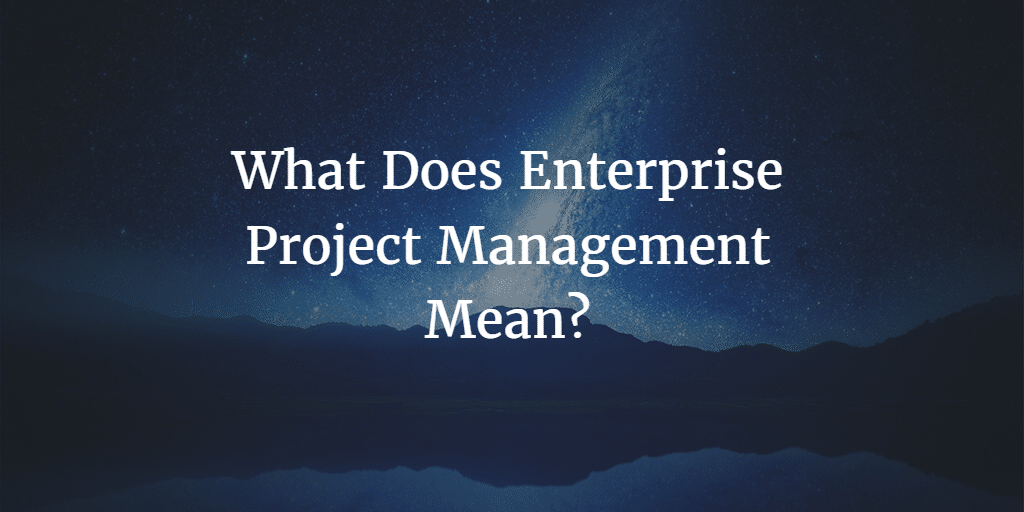In this day and age, more and more businesses are doing the majority of their work online. This means that they’ve shifted to digital resources above paper resources. With more businesses going paperless, it’s important to understand how to organize and collaborate effectively through digital media. Enterprise project management is a field of organizational development dedicated to just that. Using the available resources, businesses organize their projects according to an established system of information. What does this mean, exactly?
All projects should be able to be managed at once through the same system. A streamlined business will operate more efficiently and finish projects more quickly. Using organizational systems allows businesses to intelligently disperse their resources.
The History of Enterprise Project Management
Enterprise project management has conceptually existed for thirty years. In the 1990s, organizational systems tended to focus on individual projects. As companies move to digital media which can handle larger tasks, enterprise project management has stretched to encompass multiple simultaneous projects. In its first conception, organizational systems often didn’t include portfolios. But with IT management, many businesses are using their organizational systems to both keep track of their data and build substantiated portfolios with it. In this way, enterprise project management is helpful not only during projects, but after their completion as well.
The Difference Between Traditional Project Management and Enterprise Project Management
Traditional project management exists on a much smaller scale than enterprise project management. This is good for small businesses and smaller business projects. But large corporations investing in complex projects need a stronger system of organization. Enterprise project management considers a variety of factors which would be overlooked in traditional project management. This organizational system utilizes data analytics, risk analysis, and scaling practices to properly distribute company resources. Enterprise project management is essential for large companies with multiple projects or complex clients.
Another big difference between traditional and enterprise project management is the combination of resources. Traditional project management tends to have spread-out resources, which can be difficult to consolidate into one picture. This approach works for less complex endeavors. But enterprise project management allows a company to fit all of their relevant project data into one software.
The Benefits of Enterprise Project Management
There are several benefits to choosing an enterprise project management approach above a traditional approach. Consolidating resources into one software allows project managers to know what they’re working with at a glance. It also allows them to more easily interpret data and analyze what’s needed for the completion of the project. In traditional project management, project managers are often working alone or nearly alone. Enterprise project management allows project managers to connect to each other as well as to the employees working with them on their endeavors.
With the right software, enterprise project management turns from a complex-sounding organizational system into an easy tool right at your fingertips. If a business is taking on complex projects or complicated clientele, they’re already invested in the complications inherent in enterprise project management. Project managers will quickly find that a more extensive and involved organizational tool is the best option for execution their work quickly and efficiently.
Can Small Projects Work With Enterprise Project Management?
Yes! Small businesses and small projects can also reap the benefits of an enterprise project management approach. Even though these project may be less complex, the streamlining tools inherent in management software will make organizing and executing projects easier. It’s important to understand which company resources are being put toward which projects, and it’s also important to understand how to analyze and interpret the data associated with projects. Whether you’re using traditional project management or enterprise project management, you need to keep your plans and resources well-organized.
The Picture of Enterprise Project Management
Using enterprise project management approaches allows you to turn several small pictures into one much larger picture. This is great for businesses that need to show comprehensive plans to higher executives or potential investors. Enterprise project management does the following to streamline the project planning experience:
1. The approach adopts a consistent process and management method regardless of who’s at the helm. This is exceptionally good for businesses with several project managers who all have their own style of organization.
2. The approach allows you to scale and tailor multiple projects at once. In this way, you never overuse your company resources. You also have easy access to data and analytics. This is ideal especially if your company is working on several related projects at once. You may need to see data and analytics for more than one project, or see how this data relates to the other projects at hand, without sacrificing the individuality of each project.
3. You can establish a Project Management Office using your project management software and resources. A project management office is essential for large businesses undergoing several complex projects at once. The office will support standard processes and tools, as well as establish a unified framework for employees to work within. An office also gives you easy access to resource and cost analysis on top of project reporting.
4. You can use the available software to establish a project life-cycle model to guide processes to completion. Once you’ve put together one life-cycle model, you’ll be set for years. One project model can sustain multiple projects at once, taking a lot of the heavy lifting out of project planning and resource utilizing. Having an available framework for projects can also help to streamline your company’s approach regardless of how many project managers are working at a time.
5. You can use the available software to establish governance processes and project control capabilities. This means that the heads of the company will be able to participate in complex projects. Project managers will also be able to give quick updates on the states of their current projects, as well as project time and resources they need to finish said projects.
6. You can deploy the enterprise project management software tools to all project managers in a company. This is another way of ensuring consistency and quality. When project managers have a specified framework to operate in and specialized tools to use, their work will become more cohesive.
What Enterprise Project Management Software Is the Best For My Business?
The Leankor visual workflow software is a great software for enterprise project management. With Leankor, businesses have access to a wide variety of features and organizational tools. Some of Leankor’s goals are as follows:
1. Automate processes. Leankor aims to automate business processes to save time and improve company efficiency.
2. See team workflow. Leankor allows project managers to see what each member of their team is working on at any given point in a project’s life cycle. It also allows them to redirect employees according to given data.
3. Receive data. Project managers using Leankor can receive project data in real time. This is great, especially when working with clients who often revise their project details. It’s also great for project managers who need to closely supervise several parts of the creation process at once. Real time data updates mean that managers never miss anything.
4. Build projects. Leankor ultimately offers an ideal framework for future projects, streamlining the complex project management process into something easier to visualize.
What Features Does Leankor Offer?
Leankor comes with a variety of features to suit several types of complex project. Included in the Leankor package are some of the following:
1. Visual management. Leankor comes with a host of visual management tools for project managers and employees alike. Sixty-five percent of people learn and think visually. Using visual management tools allows people to know where projects stand at a glance, and it’s also helpful for creating presentations for potential investors or company executives.
2. Mixed modal methodology. This methodology allows project managers to communicate and collaborate across project lines. This is a great feature for companies whose managers are working on a series of interrelated projects.
3. Real time visibility. The Leankor software updates in real time, allowing project managers and employees to see new developments through their network. Everyone is always on the same page, and no one is ever left behind. This is great for project managers who need real time data.
4. Flexibility. Leankor is optimized for use by anyone. The options are easy enough that there’s no need to involve a company IT team in project setup. Once the software is available, it’s ready to go. Businesses can pick and choose which visual data they need to represent as well as which projects to prioritize.
5. A world class platform. Leankor is built on a SalesForce platform, which allows maximum security and enterprise scalability. This means that a wide variety of projects are supported regardless of their complexity level. Project managers from small businesses will benefit from the Leankor software just as much as managers from larger corporations.
Leankor has free trials of their software available through their website. Business owners looking for comprehensive enterprise project management would do wonders for their companies by giving it a try. Once you try this approach to organizational systems, you’ll never want to go back.






